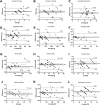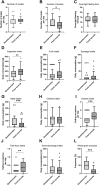Dietary assessment in intermittent fasting: validation of a short food frequency questionnaire vs. food records in diurnal dry fasting and time-restricted eating
- PMID: 40791239
- PMCID: PMC12336244
- DOI: 10.3389/fnut.2025.1552990
Dietary assessment in intermittent fasting: validation of a short food frequency questionnaire vs. food records in diurnal dry fasting and time-restricted eating
Abstract
Objectives: Food frequency questionnaire (FFQ) is a cost-effective method of dietary assessment in nutritional and clinical research. It can be easily adapted to different research questions or populations, but modified versions require careful validation. This study assessed the validity of a short 14-item semi-quantitative FFQ compared to weighted food records in a secondary analysis of an intermittent fasting trial.
Methods: Dietary assessment was conducted during the ParoFastin study, a controlled trial investigating the effects of religious Bahá'í fasting (19 days of diurnal dry fasting) and 16:8 time-restricted eating (TRE) on oral health and metabolic state compared to the habitual food intake. Daily consumption of meals, snacks, food groups, and overnight fasting time were assessed using both the short FFQ and food records. Food records were collected for 1 week at baseline and 19-21 days during the intervention and analyzed using PRODI®, a professional dietary assessment software. The FFQ was completed once at baseline and twice during the intervention. Its validity was assessed using correlation and method agreement analysis, including Bland-Altman plots for continuous data. Energy and macronutrient intakes were quantified using food records only.
Results: Eight men and seven women, with a median age of 29 (27-34) years, were included in the validation analysis. Correlation coefficients ranged from 0.189 (tendency to snack) to 0.893 (meat consumption). Tendency to snack, frequency of snack consumption, and frequency of whole grain consumption showed insufficient agreement between the two methods. However, most questions of the short FFQ were found to be statistically valid in this population. According to food records, the energy, fat and carbohydrate intake were reduced during the Bahá'í fast and remained unchanged in the control and TRE groups compared to the baseline, while analysis of these parameters was not feasible based on the short FFQ.
Conclusion: Overall, good agreement for the methods was found, although data on snack tendency, frequency of snack consumption, and whole-grain consumption were unreliable, indicating a need for questionnaire modifications. In contrast to time-consuming food records, the short FFQ can be effectively used in clinical trials and medical practice for specific goals.
Clinical trial registration: https://drks.de/search/de/trial/DRKS00026701 German Clinical Trials Register (DRKS); identifier DRKS00026701.
Keywords: dietary assessment; food frequency questionnaire; intermittent fasting; religious fasting; time-restricted eating; validation.
Copyright © 2025 Schüssler, Pappe, von Scheidt, Peters, Dommisch, Kessler, Michalsen, Koppold and Pivovarova-Ramich.
Conflict of interest statement
AM and DK co-founded the Academy of Integrative Fasting (AIF). AM is also co-founder of the SALUFAST company, and DK serves as a consultant for a mobile application on intermittent fasting (FASTIC), as well as a company producing plant-based supplements (EVERYYIN). AM and DK are board members of the Medical Association for Therapeutic Fasting and Nutrition (Ärztegesellschaft für Heilfasten und Ernährung e.V.). The remaining authors declare that the research was conducted in the absence of any commercial or financial relationships that could be construed as a potential conflict of interest. OP-R declared that she was an editorial board member of Frontiers, at the time of submission. This had no impact on the peer review process and the final decision.
Figures





References
-
- Peters B, Pappe C, Koppold D, Schipp K, Arnrich B, Michalsen A, et al. Twenty-four hour glucose profiles and glycemic variability during intermittent religious dry fasting and time-restricted eating in subjects without diabetes: A preliminary study. Nutrients. (2024) 16:2663. 10.3390/nu16162663 - DOI - PMC - PubMed
-
- van Staveren W, Ocké M, de Vries J. Estimation of dietary intake. 10th ed. In: Erdman J, Macdonald I, Zeisel S. editors. Present knowledge in nutrition. Hoboken, NJ: John Wiley & Sons, Inc; (2012). p. 1012–26.
LinkOut - more resources
Full Text Sources

